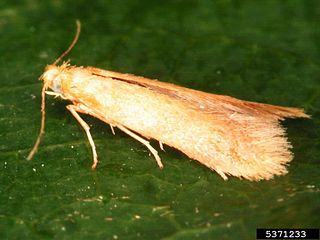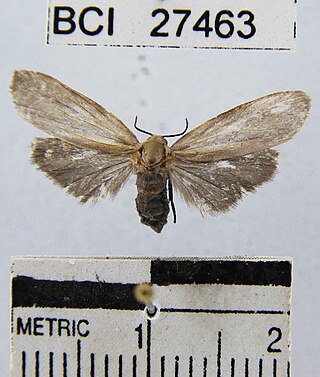
The Lymantriinae are a subfamily of moths of the family Erebidae. The taxon was erected by George Hampson in 1893.

Tischerioidea is the superfamily of "trumpet" leaf miner moths. The superfamily contains just one family, Tischeriidae, and traditionally one genus, Tischeria, but currently three genera are recognised, widespread around the world including South America, except for Australasia. This is one candidate as the sister group of the bulk of Lepidoptera, the Ditrysia, and they have a monotrysian type of female reproductive system. These small moths are leaf-miners in the caterpillar stage, feeding mainly on Fagaceae, Asteraceae, and Malvaceae (Astrotischeria), and some also on Rhamnaceae, Tiliaceae, and Rosaceae.

Nepticulidae is a family of very small moths with a worldwide distribution. They are characterised by eyecaps over the eyes. These pigmy moths or midget moths, as they are commonly known, include the smallest of all living moths, with a wingspan that can be as little as 3 mm in the case of the European pigmy sorrel moth, but more usually 3.5–10 mm. The wings of adult moths are narrow and lanceolate, sometimes with metallic markings, and with the venation very simplified compared to most other moths.

Euphilotes is a genus of butterflies in the family Lycaenidae, which consists of a number of species found in western North America. Some of the species are endangered, such as the Smith's blue, Euphilotes enoptes smithi.

The Phaegopterina are a subtribe of tiger moths in the tribe Arctiini, which is part of the family Erebidae. The subtribe was described by William Forsell Kirby in 1892. 469 species of Phaegopterina are present and 52 that are recently discovered in Brazil.

Amphelarctia is a monotypic moth genus in the family Erebidae described by Allan Watson in 1975. Its single species, Amphelarctia priscilla, was first described by William Schaus in 1911. It is found in French Guiana, Venezuela, Ecuador, Peru, Suriname and Costa Rica.
Apeplopoda is a genus of tiger moths in the family Erebidae. The genus was erected by Watson in 1980.
Cheliosea is a genus of tiger moths in the family Erebidae described by Watson in 1980. The moths in the genus are found in Australia.

Clystea is a genus of moths in the subfamily Arctiinae. The genus was described by Watson in 1980.
Euchlorostola is a genus of moths in the subfamily Arctiinae. The genus was described by Watson in 1980.

Euthyone is a genus of moths in the subfamily Arctiinae. The genus was erected by Watson, Fletcher and Nye in 1980.
Micragrella is a genus of moths in the subfamily Arctiinae. The genus was erected by Watson in 1980.
Paralpenus is a genus of moths in the subfamily Arctiinae from the Afrotropics. The genus was described by Watson in 1988.
Regobarrosia is a genus of moths in the family Erebidae described by Watson in 1975.

Viviennea is a genus of moths in the family Erebidae. The genus was described by Watson in 1975.

Himerarctia docis is a moth of the family Erebidae. It was described by Jacob Hübner in 1831. It is found in French Guiana, Guyana, Brazil, Colombia, Peru and Bolivia.
Himerarctia griseipennis is a moth of the family Erebidae. It was described by Walter Rothschild in 1909. It is found in Brazil.
Himerarctia laeta is a moth of the family Erebidae. It was described by Watson in 1975. It is found in Brazil.
Himerarctia viridisignata is a moth of the family Erebidae. It was described by Watson in 1975. It is found in Brazil.
Melanarctia is a genus of moths in the family Erebidae. The genus was described by Watson in 1975.











